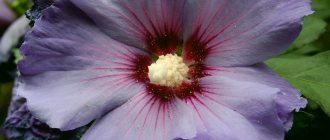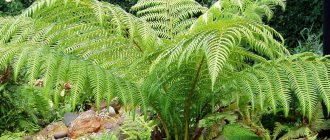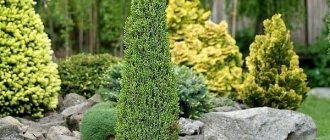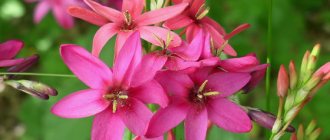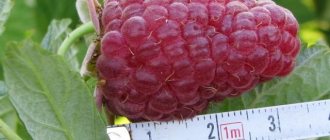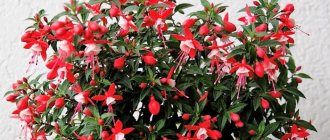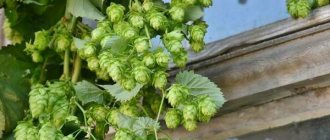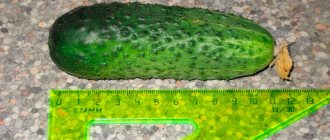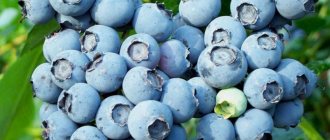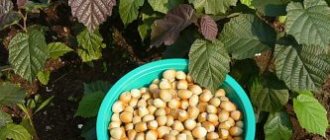1 375
Today, the columnar peach is still considered an exotic tree in most regions of our country. But, thanks to the efforts of breeders, new forms of such a crop have been developed that are resistant to temperature changes. Thanks to this, many gardeners have the opportunity to grow columnar honey peach on their own plot.
Below we will look at what this peach variety is, what characteristics it has, and how to grow this crop yourself in your front garden.
General characteristics and varieties
This relatively new variety of fruit trees is classified as a dwarf crop, their height does not exceed 2-2.5 m, and their width is 70-90 cm. The crown resembles a cylinder or column, which is why the peach got its name. It looks good in any home interior. Peach trees are very beautiful during the period of flowering and ripening of fruits. The foliage is dark green and rich in color. The leaves are oval in shape, with sharp tips. The inflorescences are small, the color is pink. Many varieties of columnar peach are distinguished by good drought and frost resistance.
The peculiarity of the culture is that the growth of branches comes directly from the main conductor; there are no branches on the side shoots. Therefore, the fruits are located close to the trunk. The weight of one fruit reaches 250 g. From one plant, depending on the variety and care, you can harvest 5-7 kg of ripe peaches. The following varieties are popular in our country:
- Honey. The plant reaches 1.5-1.8 m in height. Ripe peaches are yellow with a pink tint, slightly pubescent, and sweet. Ripen by mid-July.
- Golden triumph. A low tree, growing no more than 1.3-1.5 m in height. Winter-hardy variety, resistant to diseases. Ripe fruits are red in color, with juicy pulp and a characteristic odor. One plant can produce up to 10 kg of fruit per season.
- Steinberg. The culture grows well even in the shade and in drought conditions. The height of the tree reaches 2 m. The fruits are light orange, sweet, juicy, weight – 100-150 g.
- Totem. The variety is distinguished by large fruits (250-280 g) and tall growth (1.8-2 m). Ripe peaches are rounded, slightly flattened, yellow-orange. Fruits are well stored in cool conditions and can withstand long-term transportation.
- Anniversary of the capital. An early ripening variety, the harvest can be harvested in early July. The culture is short (1.3-1.4 m), resistant to cold and fungal infections. The fruits are round, yellow outside and inside, the weight of one fruit is 120-200 g.
Varieties such as Pendant, Souvenir, and Ring are also gaining popularity. All of them are small in size and actively bear fruit.
On a note! Low-growing varieties can be grown in tubs or large flower pots.
What time do you prune a peach?
There are several pruning dates according to the calendar, which are determined by seasonal weather changes. The manipulation is performed in the spring, this procedure is for the formation of the correct crown. This is done after the snow has melted and the soil in the garden has dried, when the air temperature reaches a stable +5˚ C. Depending on the region, this temperature is observed in March or April.
It is believed that the signal for the end of the right time for pruning is the blossoming buds. If you carry out the manipulation further, without focusing on this, you can ruin the peach, since a large volume of nutritious juice will be lost through fresh damage. There are two main points that affect pruning. The first is to remove all the young shoots that are not able to support the weight of the fruit. And secondly, thin branches interfere with the peach tree in winter, as they freeze out and because of this they are removed in the spring. The main advantages of pruning in the spring season:
- strengthening the “skeleton” of the tree;
- plant rejuvenation;
- increasing productivity;
- along with the removed shoots, the larvae and pupae of pests are also removed;
- the crown will become evenly illuminated, which will not slow down the fruiting of the lower branches.
There is summer pruning, which begins after a seed appears in the middle of the fruit. It is called sanitary because during this season shoots that dry out are cut off. The cutting areas will have time to “live out” until winter. After the manipulation is completed, the nutrients will be distributed differently and will go to those branches on which the fruits ripen, which improves the quality of the fruits. But many gardeners do not like to prune in the summer - the branches are poorly visible due to the foliage. However, summer pruning is mandatory as it helps normalize the harvest.
In autumn, manipulation is carried out only in areas where the climate is quite mild - coastal and southern regions. In areas with a harsher climate, the plant will not have time to heal its wounds before winter and may freeze out. Autumn pruning is the preparation of a fruit tree for wintering; during it, all shoots are pruned. Healthy and thick ones are shortened a little, but thin or fragile ones (which can easily break) must be cut off completely. Also remove those shoots whose bark is damaged by pests.
Attention!
All pruned shoots, especially those with bark damaged by harmful insects, are burned. Most likely, they contain eggs, larvae, or direct pests that have hidden from frost under the bark and are preparing to spend the winter there.
Columnar peach: planting and primary care
To get the desired result, you need to choose the right planting material and follow the specifics of the planting process. It is better to purchase an annual plant. When purchasing, you should pay attention to the appearance and condition of the root ball. Planting material should look healthy, strong, without dry or rotten roots. The price of a seedling is quite high, so it would be a shame to purchase a sick, non-viable tree.
You may be interested in:
Peaches in syrup - we prepare for the winter without sterilization We prepare peaches in syrup for the winter, without sterilization and without citric acid. For the recipe, choose fruits that are dense, without...Read more...
Time
The timing of planting columnar peaches depends on the climate of the area. In warm areas it is recommended to plant dwarf peach crops in the fall, and in cold areas in early spring. Young trees need time to take root in a new place, take root well and adapt. After this, they will more easily tolerate sub-zero temperatures.
Place
The further growth of the seedling depends on the choice of place for planting. The area should be well lit (partial shade is allowed), without drafts. Columnar peach seedlings do not develop well in dark, swampy areas. In addition, the risk of developing fungal infections increases, and roots may rot.
Once a location has been chosen, preparatory work needs to be done. This is done in advance. For autumn planting - 30 days before planting, and for spring planting - in autumn. You need to remove the grass from the area, then dig up the ground, adding humus or rotted mullein in the process.
Planting scheme
The size of the planting holes is determined by the size of the root ball. Usually it is enough to dig a hole 60-70 cm deep and 50-60 cm in diameter. Planting algorithm:
- To avoid stagnation of moisture, a 10-12 cm layer of drainage should be laid at the bottom of the hole. For this, you can use crushed stone, broken bricks, coastal pebbles, etc.
- Place a layer of chernozem approximately 10 cm thick on the drainage.
- Place a garter stake in the hole.
- Straighten the roots of the seedling and plant it vertically in the hole. Sprinkle with soil, tamp down a little, sprinkle again. Repeat until the hole is completely filled.
- Tie the seedling to a support.
- Water with warm water (10-15 liters per seedling).
After planting, the soil above the root system can be mulched with sawdust or old leaves and pine needles. This will protect the seedling from drying out, cold, heat, wind, and will also help retain nutrients in the ground.
Important!
When filling the soil, you need to make sure that the neck of the plant remains above the surface, otherwise the tree may die.
Healthy seedlings easily take root in a new place. In the future, you just need to properly care for them.
Caring for dwarf fruit trees in open ground
Caring for columnar fruit trees has a number of subtleties. By following them, you can achieve active growth of seedlings, as well as a good harvest.
After planting, seedlings need to be watered regularly in the first months. After this, moisture is added as the soil dries.
You need to make sure there is no excess water. It leads to rotting of the rhizome.
There is no need to add fertilizers in the first season after planting the orchard. They are introduced starting from the second year of tree life. To do this, mineral and organic compounds are used twice a year.
Weeding and mulching
Weeding is dangerous for dwarf fruit trees. This procedure may damage plant roots located near the soil surface.
It is better to mulch the soil using:
Thinning inflorescences
In the first year of a tree's life, its inflorescences are removed, preventing it from bearing fruit. This must be done so that the seedling directs all its forces to:
- strengthening the rhizome;
- active growth.
To do this, all flowers are picked off.
In the next few years, the number of inflorescences is regulated, because the fragile young trunk may not withstand the weight of the crop. Of 5-7 pieces, 2 flowers are saved, the remaining inflorescences are cut off with pruning shears.
To form a beautiful columnar shape of the crown of a seedling, you need to regularly prune it. In the first year, the length of the side branches is reduced and the growth of the crop is directed upward.
The fragile trunk of a young tree does not tolerate winter cold well. In the first year, you need to make a shelter that will help you survive the frosts. Suitable for this:
- spruce branches;
- organic mulch;
- agrofibre.
Aftercare rules
Caring for columnar peaches is easy. Basic activities include fertilizing, weeding, watering and disease prevention.
Top dressing
Timely application of fertilizers will help the crop endure cold months more easily and bear fruit abundantly in warm ones. For feeding, it is better to use not chemical compounds, but natural ones, made from natural ingredients.
In early spring, before the buds open, the crop should be treated once with urea. To prepare the solution, mix 800 grams of the product in ten liters of warm water. During flowering, fruit setting and ripening, the tree should be sprayed weekly with a decoction of burdock leaves, lemon balm, and onion peels. For five liters of water you will need 100 grams of each component. They must be placed in water, brought to a boil, reduced heat and left for 20-35 minutes. After this, cool, strain, add 10 grams of ground red pepper, 100 ml of liquid laundry soap, and mix. Spray in the evening or morning. The decoction will not only nourish the plant, but will also prevent the development of rot and protect against insects.
In the fall, the tree can be fed with bird droppings or rotted mullein. To do this, the soil around the plant must be dug up, and fertilizer must be added during the digging process.
You may be interested in:
How to properly prune a columnar apple tree in the fall: features, timing, diagrams The dream of any summer resident is a garden that quickly enters the time of fruiting. Columnar apple trees allow you to realize this...Read more...
Watering
It is necessary to moisten the soil only in the first 1-2 years after planting, as it dries out. Then there will be enough natural precipitation for watering. You will have to water only in particularly dry months (once every 14 days). One tree will require 10-15 liters of warm water. After watering, the soil around the peach needs to be loosened to ensure good aeration and prevent a lack of oxygen in the root system.
Weeding
Peach trees need careful weeding. Even if each planting is mulched, you still need to weed the rows and loosen the soil. The reason is that parasitic insects often live and breed in weeds, which can subsequently attack the tree. In addition, weeds pull nutrients from the soil, depleting it. As a result, the peach may lack the necessary elements, get sick and develop poorly.
On a note!
In the first year of planting, it is recommended to remove all blooming inflorescences on the tree. This will help the plant gain strength for successful fruiting in the future.
In cold regions, peaches should be insulated for the winter. After the leaves fall, the peach should be carefully wrapped with greenhouse film or other non-woven material. The ground can be covered with spruce branches, straw, etc.
Feeding
Columnar peach, like all other cultivated plants, needs timely feeding and processing. It is better to produce them without the use of chemical fertilizers, preparing all the mixtures yourself from natural ingredients.
- In the spring, when the buds have not yet blossomed, the plant is treated with urea at the rate of 0.7 kg of the substance per 10 liters of water.
- During fruiting and flowering, the tree should be sprayed with a decoction of lemon balm, orange peels, onion peels, burdock or red pepper. The composition must include laundry soap, thanks to which the fertilizer will best linger on the leaves. This treatment will help prevent the development of disease and the appearance of pests. It is best to carry out this procedure once a week.
- In autumn, the peach tree should be treated with a 10% urea solution. It is also possible to use manure or bird droppings.
Why is pruning needed, what tools are needed?
One of the advantages of the columnar peach is that its crown does not require gradual formation. All you need to do is trim the branches regularly. The amount of harvest and the appearance of the tree depend on how correctly and timely the pruning is done.
To perform quality pruning, you should purchase the following tools:
- pruner;
- wood hacksaw;
- garden knife;
- whitewash brush.
To reduce damage to the tree, you need to control the sharpness of the sharpening of the tool. The sharper the knife or pruning shears, the easier it is to work, because the branches do not break, but are cut smoothly and neatly.
Varieties
Pruning columnar peach can be done for different purposes. For example, economic pruning involves the removal of dry, damaged, broken branches. Restoration is carried out after damage to the plant by frost, and detailed - to thin out the branches. In general, manipulation is divided into the following types:
- Formative. The main goal of the procedure is to stimulate the growth and development of the peach tree. After pruning, young branches become stronger, which has a positive effect on the yield and taste of the fruit. Formative pruning should begin when the plant is two years old. In this case, the branches are shortened, starting from the top ones, by about 15 cm.
- Restorative. This is carried out only if the tree is damaged by disease or frost. Performed in autumn or spring. The damaged shoot must be completely cut off, and the cut area should be whitewashed with garden whitewash.
- Rejuvenating. Old branches are removed in order to rejuvenate the tree and prolong the fruiting process. You need to cut down all shoots that are more than five years old.
- Regulatory. It can be carried out at any time of the year (except winter) to maintain good fruiting and control the number of fruits. In this case, it is necessary to shorten young shoots that have reached 50 cm or have strayed from the general shape of the crown.
Before pruning, the tool must not only be sharpened, but also disinfected. You can use regular alcohol for this.
Important!
Cut branches affected by fungus or other diseases must be burned to prevent the spread of the disease.
Basic landing rules
It will be possible to grow a columnar peach if you take into account the rules. They select a planting area in advance, prepare the soil, maintain soil moisture levels, and carry out preventive treatment against pests and diseases. The seedling will produce 10-15 kg of fruit with proper care. The planting will be resistant to any negative factors.
Choice of terms
Planting of columnar peach in the fall is carried out in the southern regions. In the northern regions, planting is carried out in the spring. The tree quickly adapts and tolerates any temperature fluctuations.
Important! For planting, it is better to give preference to annual seedlings. It is better not to purchase plantings older than 3 years
In this case, the survival rate is minimal, and replanting will be stressful for the plant.
Selection of location and soil
An area with a high level of lighting is prepared for plantings. This will ensure the seedlings full growth and development. Shaded areas are more likely to develop diseases.
Preparatory work on the site begins in advance. Excess vegetation and debris are removed from the soil. The planting site is dug up and saturated with useful components. Humus or rotted manure is added to the soil. If a seedling is planted in the spring, then all preparatory measures are carried out in the fall, and vice versa.
A planting pit about 70 cm deep is dug under the fruit. When planting several seedlings at the same time, a distance of 50-70 cm is maintained between them. A drainage layer is made at the bottom of the hole - a small amount of crushed stone is poured. Sprinkle soil mixed with compost on top. It is not recommended to plant trees in lowlands. This leads to constant accumulation of moisture and death of the plant.
Seedling preparation and planting
Planting columnar peaches in the spring does not present any difficulties for beginners. For a seedling, a wooden stake is inserted into the hole in order to later tie the plant to it.
The seedling is placed in the center of the pit. The roots are straightened in the pit. The empty space is covered with soil and watered under the trunk. When planting in autumn, the tree is wrapped in burlap. The planting site should not be swampy or the tree will begin to rot.
Pruning by seasons
Each type of pruning has its own deadline. Violation can negatively affect vegetation and fruiting. In some cases, the shoots are cut off completely, in others - partially.
- Spring. You can start from the last days of February and continue throughout the spring. At this time, you need to shorten the branches by about one third of the total shoot growth per year. At the same time, you should ensure that branches that are 2-3 years old are preserved as intensively as possible, because they are the ones that produce the best fruits.
- Summer. During this period, it is necessary to cut off dry, abnormally growing branches that are losing color. Pruning can be done throughout June and early July.
- Autumn. The best time for pruning is in warm regions, as the tree has a long period of recovery before bearing fruit again. The process should begin after harvesting the fruits, in mid-September, and be completed by the end of October. In areas with cold winters, autumn pruning should not be carried out.
- Winter. At this time, pruning cannot be carried out. This can injure the plant and cause its death. However, winter pruning can be called a procedure that in the southern regions sometimes begins in mid-February.
If after manipulation the integrity of the bark has been compromised, you need to treat the trunk with a solution of crystalline manganese. To do this, dissolve a few grains in 0.5 liters of warm water, the color should be dark pink.
On years
When pruning, you need to take into account the age of the plant. In young plantings the procedure should stimulate growth and development, in adults it should promote fruiting, and in old plants it should prevent thickening. After planting, you can carry out the procedure for the first time, shortening all shoots by one third. Further like this:
- First year. First you need to measure the growth of branches. If it is weak, the shoots have grown less than 30 cm, then pruning is not necessary. With good growth, one third of the shoots can be shortened.
- Second year. Same as first year.
- Third year. This is the fruiting period, so pruning is necessary. You can thin out the overgrown crown, cut off injured, weak, frozen branches. Shorten young shoots by a third.
Subsequent pruning depends on the age of the tree and its fruiting activity. While the plant is young, pruning can be done annually, similar to the third year. An aged peach needs to be rejuvenated once or twice a year. There is no need to form the crown of a columnar peach, but, if desired, the upper branches of an adult tree can be cut off to give it any shape. You should not allow the growth of side shoots - this will reduce fruiting. These shoots can be removed when they have just begun to develop by simply plucking them out.
Landing Features
Columnar peach is suitable for planting in temperate climates, the main thing is that it has an early or medium ripening period. Then its fruits have time to properly fill and ripen on the branches. But this characteristic does not apply to every variety. Therefore, you should consider your choice carefully. Another of his criteria must certainly concern the survival rate of plants in your region. It is best to give preference to local seedlings rather than imported ones.
The timing of planting young peach is closely related to this. In the south, this is usually done in the fall, but in temperate climates it is better to plant in early spring. To select a location, consider the following points:
Peaches do not like stagnant water and excessive cold, so lowlands are not suitable for them. They need to be planted in open sun, away from other trees, but with indispensable protection from the winds.
Having decided on the choice of location, you need to prepare a hole 0.8 m deep and 0.7-1 m wide in advance. Add a bucket of compost or rotted manure into it, mix the fertilizer with the soil in the hole and leave it like that for at least one week.
If there are several seedlings, the distance between them should be at least 50 cm. Each tree is placed in its own hole. The peach roots should be spread out well and carefully covered with soil. Next, the soil needs to be trampled underfoot and watered abundantly. If necessary, add more soil. Be sure to tie all plants to strong, tall stakes.
